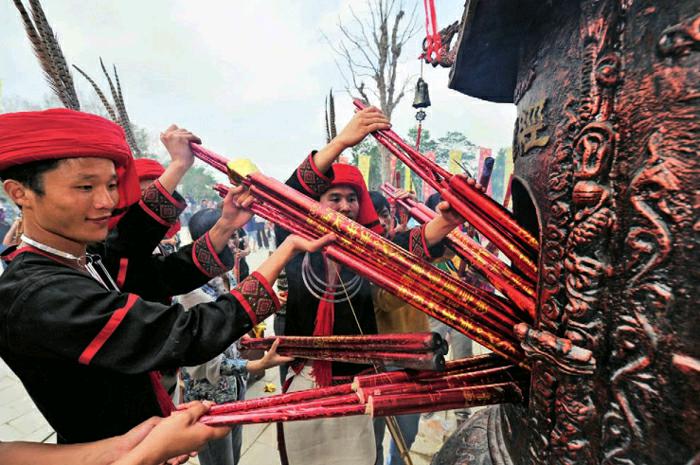Double Third Festival:A Big Day for the Li Ethnic Minority
THE Li ethnic minority is concentrated on Hainan Island and most of its people still live in an agrarian society. On the third day of the third lunar month(Double Third Festival), Li communities across the island hold various celebrations. Known as Funianfu in the Li language, it is a day for young people to find a partner and for everyone in the community to commemorate their ancestors. The festival was listed as a national intangible heritage in 2006.
The Tale of the Lark Girl
Once upon a time, the people on Hainan Island were blighted with an unusual drought. One day, a young man named Yayin dreamed that a lark would help the people survive. When he woke up, he took his nose flute and climbed to the top of Wuzhi Mountain. Three days and nights he spent on the mountaintop, and eventually the melody of his flute attracted a lark. Yayin chased the bird through the mountains until it was too exhausted to fly any further. Suddenly it transformed into a beautiful girl. Moved by Yayins sincerity, the girl agreed to help the people of Hainan.
The Lark Girl saved the people from the terrible drought, but soon afterwards a chieftain coveted the girls beauty and ordered his servants to capture her. When he heard that the Lark Girl was in danger, Yayin rushed to save her. They hid together in a cave. The chieftain, in his jealousy, gave orders to set the cave on fire, but at that very moment dark clouds gathered and thunder roared. Suddenly the mountain collapsed and rocks cascaded down, crushing the chieftain and his servants to death. People saw Yayin and the girl transform into birds and soar into the sky. They wished the couple well with much singing and dancing.
This is said to have happened on the third day of the third lunar month. The date has been an important festival for the Li people ever since, and is a symbol of Li culture.
The story of Yayin and the Lark Girl is a classic example of a Chinese folk tale. Told and retold amongst folk communities since ancient times, these oral histories are passed from generation to generation and are a treasured part of their culture. Mirroring everyday life, these stories often reflect the way people relate to the world around them and the values upheld by their communities, praising integrity, diligence, kindness, and wisdom, while dismissing laziness and selfishness.
Liberal Marital Customs
To better understand this festival for young lovers, a look is needed at the marital customs of the Li people. Li people are monogamous. When they marry, a young man or woman leaves his or her pa-rental home and moves to their own house nearby. Instead of living under the same roof as many Chinese couples do, Li newlyweds have an independent life as soon as the young couple moves in together. Though parents often play a decisive role in their childrens marriages, boys and girls have the freedom to choose their spouse. The Li ethnic group advocates a climate of tolerance towards women. Married women can live with their parents for years before they are ready to move in with their husband. A woman is also free from criticism if she decides to divorce her husband, and the community does not oppose the remarriage of widows. Illegitimate children are also treated equally by the community.
This open attitude cultivates a freedom in love that forms the foundation of the Double Third Festival. The ceremony is usually held in rubber tree forests, an intimate environment for the exchanging of lovers vows – cool shade overhead and thick leaves on the ground like a carpet make a heavenly setting.
The most exciting part of the festival starts when the sun goes down. Girls in glowing costumes and boys with red belts around their waists sing and dance around the campfire. Boys hold colorful umbrellas, while silver and shell ornaments on the girls dresses glitter in the firelight. Starting with soft, slow love songs, the gala becomes increasingly lively and exhilarating. Participants take part in traditional dances, such as the betel nut dance, bamboo pole dance, firewood-cutting dance, and hunting dance.
When night falls, boys and girls who have found a partner will move away from the carnival to quiet corners where they exchange gifts to show their mutual affection. Girls usually receive earrings or hairpins made of deer bone and they tie colorful hand-knitted belts around the waist of their lover. Couples vow to meet again on the same day the following year.
This tradition of finding a lover by singing and dancing is over 2,000 years old. Seeing as the story and the traditions behind the festival are all about love, the Double Third Festival is also known as the Love Festival.
Ancestor Worship
In addition to love, ancestor worship is very important on this big day. As followers of a pagan religion,the Li people have always had a deep respect for their ancestors. On the Double Third Festival, they put on their festival clothes and bring homemade pickles, rice wine, and gifts of pastries to prestigious elders. Then people gather around Wuzhi Mountain to hold a ritual worshipping their ancestors. Young men often go hunting and fishing and bring back their trophies for young ladies to cook. The food offerings are laid in front of a cave in which some Li ancestors, a couple, are said to have been mummified after death. After the commemoration, the younger generation will take part in a series of activities including an archery contest, pole climbing, wrestling, tug of war, and playing on a swing.
Since 2014, the festival has been celebrated on a larger scale with more varied events in a cultural park at the foot of Wuzhi Mountain. In the language of the Li people, the ritual is named after Paolongkou, a god boasting immense strength.
According to Li legend, in ancient times the sky and earth were not separate. Day and night could not be distinguished because seven suns and seven moons always hung in the sky together. The earth was burning; rivers and oceans were drying up. Not even a blade of grass grew, and people were in mortal danger. Feeling for the people, Paolongkou decided to make use of his strength. He shot arrows at the suns and moons until only one pair were left. Using a rainbow as a shoulder pole and roads as ropes, he carried soil and rocks to create mountains. He proceeded to chisel gullies into the rock, turned his sweat into rivers and his hair into trees. Having spared no effort in creating a better environment for everything on earth, Paolongkou died from sheer exhaustion. However, with his dying breath, he held up his hand to become a mountain in order to prevent the sky from falling on the people below. This is why Wuzhi Mountain has the name it does – Wuzhi literally means “five fingers.”
The legend of Paolongkou illustrates the Li peoples relationship with nature. Due to their insular island lifestyle, nature has always been a close companion. The Li people see themselves as part of nature and are willing to co-exist and prosper together. They feel blessed with the grace of nature and they also feel grateful, awed by the power of nature. A deep sense of spirituality connects them to their natural environment. In their eyes, not only people, but also each part of creation – whether it be wind, cloud, plant, or animal – owns a body and a soul. Therefore, they worship, commemorate, and show their respect both to nature and to other people.
A god and an ancestor in the hearts of all Li people, Paolongkou is commemorated every year on the Double Third Festival. The sacrificial ceremony held at the foot of Wuzhi Mountain usually comprises two parts. Starting at 8:30 in the morning, the first ritual is hosted by venerable priests from the Li ethnic group with participation from both elders of Li communities and local Han people. The second part is open to the wider public after the performances.
Nose Flute
Played with the nose, a nose flute is a traditional instrument amongst the Li people. Its history dates back over 1,000 years among the people who live on what is now Hainan Island. Nose flutes are made from a bamboo section and vary in length and width. The most common dimensions are 60 to 70 centimeters in length and 1.6 centimeters in diameter, with a hole at the nose area for breathing and a number of fingering holes. The range of the instrument is around three octaves. Players can also perform trills and slide between notes. Nose flutes can be played solo or as part of a duet, but are also commonly used in dance performances.
- CHINA TODAY的其它文章
- Sci-Tech
- The Road of Hope
- Pakistan Showcases Achievements in Belt and Road Cooperation
- Enhancing Connectivity in East Africa: The Addis Ababa-Djibouti Railway
- Building Lifelines in Tajikistan–Tebian Electric Apparatus Stock Co.
- Chinese Projects Bring New Opportunities to Aktogay in Kazakhstan

